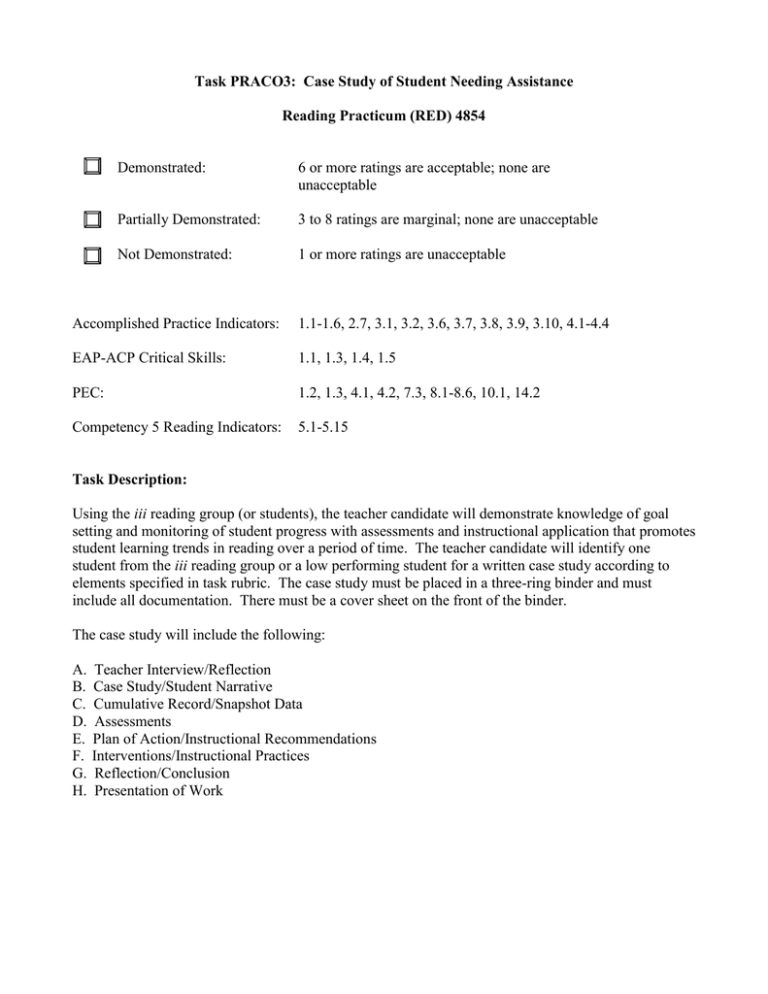Task PRAC03
advertisement

Task PRACO3: Case Study of Student Needing Assistance Reading Practicum (RED) 4854 Demonstrated: 6 or more ratings are acceptable; none are unacceptable Partially Demonstrated: 3 to 8 ratings are marginal; none are unacceptable Not Demonstrated: 1 or more ratings are unacceptable Accomplished Practice Indicators: 1.1-1.6, 2.7, 3.1, 3.2, 3.6, 3.7, 3.8, 3.9, 3.10, 4.1-4.4 EAP-ACP Critical Skills: 1.1, 1.3, 1.4, 1.5 PEC: 1.2, 1.3, 4.1, 4.2, 7.3, 8.1-8.6, 10.1, 14.2 Competency 5 Reading Indicators: 5.1-5.15 Task Description: Using the iii reading group (or students), the teacher candidate will demonstrate knowledge of goal setting and monitoring of student progress with assessments and instructional application that promotes student learning trends in reading over a period of time. The teacher candidate will identify one student from the iii reading group or a low performing student for a written case study according to elements specified in task rubric. The case study must be placed in a three-ring binder and must include all documentation. There must be a cover sheet on the front of the binder. The case study will include the following: A. B. C. D. E. F. G. H. Teacher Interview/Reflection Case Study/Student Narrative Cumulative Record/Snapshot Data Assessments Plan of Action/Instructional Recommendations Interventions/Instructional Practices Reflection/Conclusion Presentation of Work Rating Scale Key: A = acceptable, M = marginal, U = unacceptable Element (A) Teacher Interview/Reflection # 1 (0-15 pts) (B) Case Study/ Student Narrative 2 (0-10 pts) (C) Cumulative Record/Snapshot Data Criteria for “acceptable” rating Interview your supervising teacher using attached questions. Record answers and submit typed. Submit a reflection of your interview. Your reflection should clearly address the list of reading competency indicators as well as your thoughts and connections to what you have learned about assessing and teaching. 3 (0-15 pts) Rating ___A ___M ___U ___A ___M ___U Student who needs iii instruction in reading is identified in a written narrative, without violating privacy issues, and is based on the student’s background (e.g., gender, grade level, mobility rate, socioeconomic status, testing recommendations, (ESE) RTI involvement or other additional services such as speech, physical therapy, family/guardian information/dynamics, siblings, retentions and absences. Information may be provided by the student, teacher, and cumulative records. Pre-existing standardized test results are displayed in a chart or table that includes patterns of test performance for previous years (ex. FAIR, FCAT, Think-Link, STAR, and Jackson District Benchmark Assessments K-2). The data is thoroughly reviewed and reported, with appropriate overall conclusions drawn about the student’s individual needs, including strengths and weaknesses. ___A ___M ___U (D) Assessments 4 (0-15 pts) (E) Plan of Action/Instructional Recommendations 5 (0-10 pts) (F) Interventions/Instructi onal Practices 6 (0-15 pts) (G) Conclusion/ Reflection 7 (0-10 pts) Cognitive and affective needs are currently assessed comprehensively and appropriately. Assessment data is displayed in charts or tables. Summary of assessments (ex. CORE Assessing Reading-Multiple Measures, Interest Inventory, Spelling Inventory, Writing Inventory (can be the district’s), FAIR, etc.) are provided and describe key points in each area including strengths and weaknesses. There is evidence of screening, diagnostic and progress monitoring. Progress monitoring of the two areas of greatest need must occur at least every two weeks. The plans of action/instructional recommendations/practices are appropriate and clearly linked to errors from formal and informal assessments. Instructional recommendations should address strengths as well as weaknesses. The recommendations should offer detailed strategies for your student’s literacy needs. Specific interventions for the two greatest areas of need are implemented and indicate a thorough understanding of areas where the student is at risk. Use examples of assessment responses to support selected interventions. Use resources such as CORE Teaching Resource Book, FCRR resources including empowering Teachers, Student Center Activities, and the CORE Reading Program Interventions for developing the detailed lesson plans that support intervention strategies. At least one detailed lesson plan must focus on indicator 5.15 (Writing). Attach lesson plan materials and sample of student work to each detailed lesson plan. The conclusion reflection must be written in a narrative format. It should address the following questions: 1. How did the student respond to the lessons? 2. Was there evidence of learning gains when comparing pre/post assessments (ex: CORE, FAIR, benchmark assessments, spelling, and writing)? 3. What would be your ___A ___M ___U ___A ___M ___U ___A ___M ___U ___A ___M ___U (H) Presentation of Work 8 (0-10 pts) recommendations for future instruction for the case study student? Be specific. Why? 4. What would you do differently based on this case study? 5. How did your knowledge about reading assessment and instruction change throughout the case study process? What have you learned about reading assessment and reading instruction that will help you to set up your own learning environment? All written work is clear, organized, cohesive, and uses appropriate conventions and professional language. Suggested Reading Practicum Calendar/Checklist Week # and Dates 1–2 Jan.9-13 Jan. 17-20 * * * * * * 3–4 Jan. 23-27 Jan. 30-Feb. 3 * * * 5–6 Feb. 6-10 Feb. 13-17 * * Observe during the literacy block/reading class during the first week of the internship Note the various modes of instruction (whole group, small group, independent) for word work, reading and writing Conduct teacher interview using questions Begin composing your teacher interview/reflection Address listed reading competencies in your reflection Reflection due by the end of week 3 With assistance from supervising teacher, select a iii student (struggling reader) for case study Review and collect available data on iii student. See details from Rubric, Parts B and C (Task PRAC03) Week 4 – begin administering assessments from CORE 7 -8 Feb. 20 – Feb. 24 Feb. 27 – March 2 * * * Complete CORE assessments Administer spelling inventory, interest inventory and writing inventory (may use the district’s writing inventory) Compile assessment data (previous and current into chart/table format and summarize (include informal as well as formal assessment data) Develop Instructional Plan Complete 2 detailed lesson plans (1 per week) Lesson Plan #1 is due at Feb. 13 seminar Continue working on Case Study Complete 2 detailed lesson plans Progress monitor iii student 9 – 10 March 5 -9 March 12 - 16 * * Complete 3 detailed lesson plans Progress monitor iii student 11 March l9 – 23 Spring Break –March 26 -30 12-13 April 2 – 6 April 9 - 13 * * * * * * Continue working with iii student Progress monitor iii student Complete 2 detailed lesson plans Continue working with iii student Administer CORE Post-test Complete 2 detailed lesson plans 14 April 16 -20 15 April 23-27 * Complete 1 detailed lesson plan Work on case study Case study due on April 23 Final seminar meeting on 4/23 * * * * *





